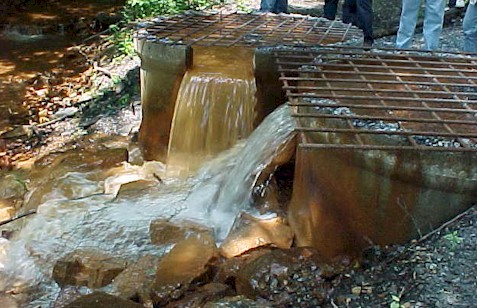
Source: The Pennsylvania Department of Environmental
Protection and the Bureau of Abandoned Mine Reclamation (BAMR)
Pamela J. Milavec, Water Pollution Biologist, Ebensburg District Office
Abstract
Pennsylvania’s most recent efforts at abandoned mine drainage (AMD)
abatement began in 1992, with the establishment
of the 10 Percent Set Aside Program using federal abandoned mine land
grant funds. Funds used for AMD abatement have also included the Appalachian
Clean Streams Initiative, bond forfeiture funds and Pennsylvania’s
new “Growing Greener” program. To date, 19 AMD treatment facilities
have been constructed by the Bureau of Abandoned Mine Reclamation (BAMR)
on 14 separate projects, with eight more facilities currently in construction.
Constructed facilities have run the gamut of available passive treatment
options, including Pyrolusite® limestone beds,
aerobic wetlands, anoxic limestone
drains, vertical flow systems of different variations and semi-active
lime dosing systems. Unforeseen problems have been encountered in both
construction and operation of the various systems. The most common construction
related problems have included encountering additional flows during
excavation, leaking ponds and difficulties attempting to manipulate
mine pool elevations. The most common operational problem so far has
been dealing with odor complaints from nearby residents due to the use
of compost in vertical flow systems, particularly when the discharges
are intermittent. Significant plugging at the entrance to a Pyrolusite®
bed has been a problem at one site. Finally, an evolving issue is the
need for more frequent and significant maintenance than was initially
envisioned with these systems.
Most of BAMR’s systems are operating successfully. Sites where
drainage is properly entering and exiting the systems at the expected
flow rate are showing very effective treatment results. In all of these
cases, effluent water quality has met or exceeded expectations. Long-term
results will likely be dependent upon the effectiveness of maintenance
components integral to these systems and BAMR’s ability to provide
resources needed for this maintenance. A site-specific water monitoring
program is ongoing to provide chemistry and flow data for evaluation
and to enhance subsequent system design. Biological stream monitoring
is also underway to determine if desired results are being achieved.
Much has been learned about passive treatment of AMD throughout the
past decade, but the learning process is ongoing.
Introduction
Pennsylvania’s long history of coal mining has left a legacy of
scarred land and polluted streams. It is estimated that at least 2,500
miles (4022 kilometers) of stream are impacted by AMD. The Commonwealth’s
earliest attempts to address these problems began in 1967 with the establishment
of the Land and Water Reclamation Fund. This program provided for $200
million to address abandoned mine land problems, including AMD (Department
of Environmental Resources, 1990). Operation Scarlift, as the abandoned
mine portion of the Fund was called, achieved limited success with respect
to AMD abatement and treatment. Projects included the development of
a large number of watershed studies (which are still in use today),
surface mine reclamation, mine sealing and the construction of several
chemical treatment plants to treat AMD. While these chemical plants
were largely successful, the cost to operate and maintain them was substantial.
Several plants were subsequently shut down. It quickly became obvious
that large-scale chemical treatment of AMD would be prohibitively expensive
for the Commonwealth.
In the 1980s, as passive treatment technology began to emerge, the Commonwealth
used some remaining Operation Scarlift funds to construct three passive
treatment systems. These systems, which consisted of a combination of
aerobic and anaerobic wetlands and ponds, were only partially successful
in removing metals and did a poor job of neutralizing acidity. It was
obvious that the technology had not yet reached the point where passive
treatment could be successful.
In 1990, an amendment to the federal Surface Mine Control and Reclamation
Act (SMCRA), allowed states to “set aside” 10 percent of their
Abandoned Mine Land Trust grant to address AMD. Prior to this time,
these funds could only be used to address health and safety problems
on abandoned mine lands throughout the country. Pennsylvania’s
10 Percent Set Aside Program, which receives approximately $2 million
per year, was established in 1992, with site evaluations beginning in
1993. The first AMD treatment systems were constructed in 1997. Also
in 1997, the federal Office of Surface Mining established a program
called the Appalachian Clean Streams Initiative (ACSI). This program
provided additional funds to states in the Appalachian region to address
AMD problems.
Most recently, in 1999, the Pennsylvania General Assembly passed the
Environmental Stewardship and Watershed Protection Act. Known as “Growing
Greener”, it invests nearly $650 million over five years to protect
and restore watersheds and reclaim abandoned mines. The Pennsylvania
Department of Environmental Protection’s (DEP) Bureau of Abandoned
Mine Reclamation administers the 10 Percent Set Aside and ACSI programs
and also receives funding from Growing Greener. These funding sources,
as well as monies from the bond forfeiture program, provide the AMD
abatement funding used by BAMR. While these funding sources are substantial,
they pale when compared to the estimated $5 billion cost to address
all the AMD problems in Pennsylvania.
Under these programs, 19 separate treatment facilities have been constructed.
Many of the projects have been or are being constructed in partnership
with a number of other agencies, including the Natural Resources Conservation
Service, the U. S. Army Corps of Engineers, the Environmental Protection
Agency’s 319 nonpoint source program, county conservation districts
and local watershed associations.

Return
to AMD Stakeholders' page
